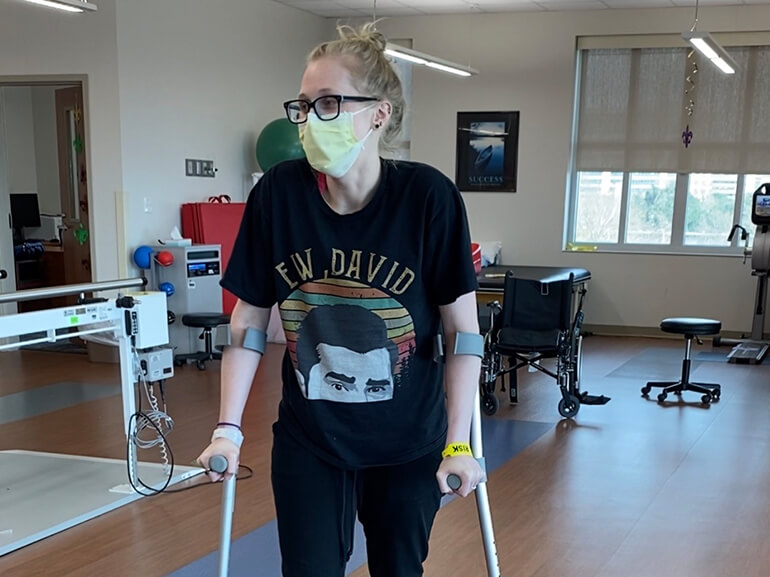Callie's Story

Callie Clark, 29, is a case manager for a Medicaid waiver program who loves her job, being outside and going to the beach. In January, she tested positive for COVID-19 and had no idea of the impact it would have on her in the weeks and months to come. Shortly after her diagnosis, Callie also came down with pneumonia. Doctors sent her home to self-treat, but she began experiencing a burning sensation and pain in both legs. The intensity limited her to walking just a few feet before she had to sit down and rest. A few weeks after her initial diagnosis, Callie could barely make it to the bathroom due to the debilitating pain. She decided it was time to go to the hospital, and her fiancé drove her to Ochsner Medical Center – Northshore.
Callie underwent several tests, including an MRI and a nerve conduction test, which indicated that she had Guillain-Barre syndrome – a neurological disorder in which the immune system mistakenly attacks the body’s peripheral nervous system. Callie recalled that shortly after being admitted to the ICU, she began to feel numbness ascending in both of her legs.
A few days later, Callie was transferred to Ochsner Main Campus where she underwent more testing before discharging to Ochsner Rehabilitation Hospital. Callie believes it was fate that she was admitted to Ochsner Rehabilitation Hospital about a month after getting sick. “I know that God put me here and I am so incredibly thankful for that every single day,” said Callie.
When she first arrived, Callie demonstrated substantial difficulty walking, completing grooming tasks and speaking or thinking clearly. Her goals were to be able to walk, dance and return to work. Callie’s treatment team -- including her physician, nurse practitioner, case manager, physical therapist, occupational therapist and speech therapist -- developed a comprehensive plan of care to help Callie reach her goals.
Speech therapy included high-level cognitive activities to improve Callie’s ability to return to work and complete her daily responsibilities. Her treatment targeted problem solving, memory, word finding, reasoning and attention skills. Callie made significant progress in cognitive functioning, though not quite to her normal speed of processing.
In occupational therapy, Callie was taught strategies to minimize deficits caused by her condition. These included energy conservation techniques to increase independence in daily life skills including bathing, dressing, transferring, as well as higher-level activities such as kitchen mobility, meal preparation and money management. Occupational therapists also provided Callie with adaptive equipment, such as a long handled shoehorn, to increase her ease and efficiency when performing dressing tasks, as well as implementation of a shower bench to maximize safety and increase her independence.
Physical therapy concentrated its efforts on improving Callie’s ability to walk. Initially, Callie used a walker, but due to the severity of her pain, her therapists found alternative equipment to complete gait training. When walking, Callie wore braces on both legs to improve her ability to clear and progress her feet. To provide weight support, Callie used the LiteGait and Tollos harness, devices which lift and support patients safely while walking. These were some of Callie’s favorite pieces of equipment to use. In addition to the harnesses, Callie worked on walking with forearm crutches. When she used these the first time, Callie found it less painful to walk. “I knew for the first time that I would be able to put those down one day.” At the end of her stay, Callie was using the forearm crutches for mobility without assistance.
During Callie’s stay, she was unable to see her family in-person due to COVID-19 visitation restrictions, however she enjoyed regular FaceTime video chats with her love ones who provided her with the motivation to continue going strong.
After three weeks at Ochsner Rehabilitation Hospital, Callie returned home with independence in walking and self-care tasks. She planned to continue outpatient therapy to keep progressing in her recovery.
Her advice to other patients going through the rehabilitation process is this: “No matter how hard it is, no matter how much you don’t want to do it, keep fighting. Always keep fighting!”